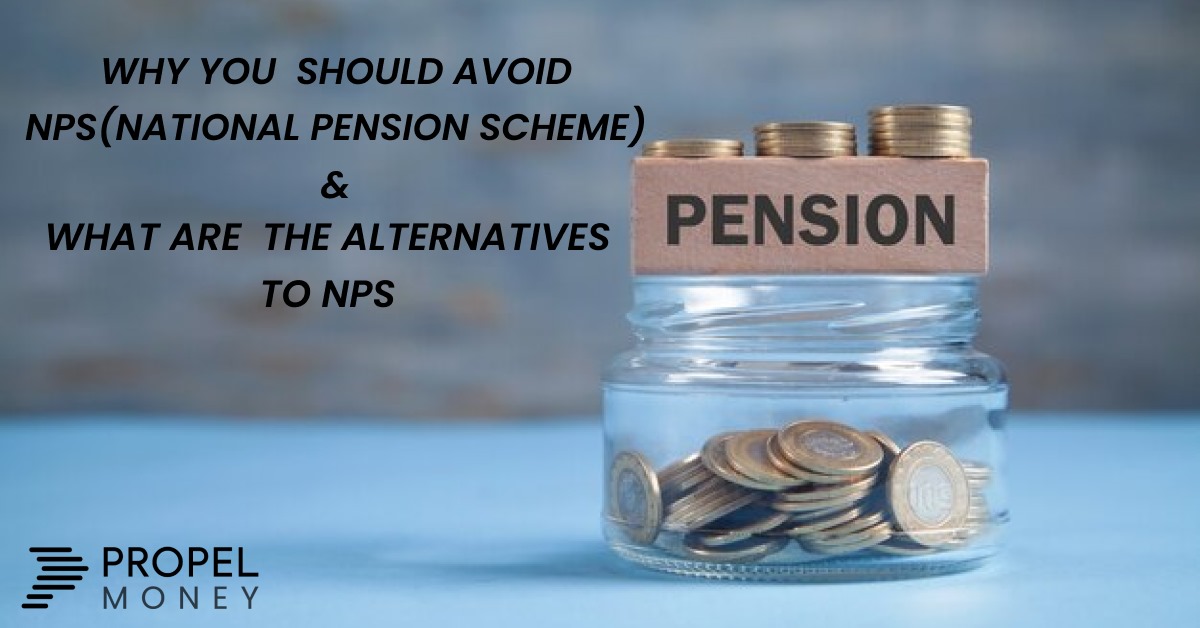NPS is an optional and long term investment plan for retirement managed by the Government and the Pension Fund Regulatory and Development Authority (PFRDA). Here’s why we suggest you should avoid NPS and what are the alternatives to NPS.
Fund choices under NPS
Your investment in NPS is in turn invested in the following four types of funds:
- Equity (max 75%)
- Corporate Bonds (up to 100%)
- Government Securities (up to 100%)
- Alternate Assets (max 5%)
While opening an NPS account, you have to choose what percentage of your investment goes into which type of fund. Your choice can be changed 4 times during a financial year.
Risk on fund choices
Every choice other than Government Securities carries risk. If you plan to invest a part other than in Government Securities, it is better to invest in mutual funds, which may offer you a better return and more liquidity (i.e ability to quickly convert to cash) and you can change it any number of times.
Even for risk-free Government Securities there are alternatives, such as PPF and mutual funds that invest only in Government Securities.
Liquidity and ability to withdraw
Further, you can withdraw the amount in NPS after you turn 60 years of age. There are limits on earlier withdrawals. Even after 60 years of age, you get only 60%, which would then entirely need to be invested at that stage.
The balance 40% has to be invested in a scheme that pays periodic pension (also called annuity scheme). Annuity schemes in general have low returns since they invest in near zero risk investments. Such returns may not be adequate to beat inflation.
We also believe it is better to have access to your entire investment after the age of 60, should you need it. So what are the alternatives to NPS? A mix of PPF and mutual funds can meet this requirement. If you are looking for a regular receipt after retirement, you can go for an SWP – Systematic Withdrawal Plan of your invested mutual funds (we always suggest going for the “Growth” option when investing in a mutual fund and not the dividend distribution – now called the IDCW option, because of the power of compounding).
Tax Benefit
However, there is a tax benefit for investing in NPS, ie the amount invested in NPS is available as a tax deduction from income. This may increase your returns beyond what mutual funds may give. This tax deduction is limited to 10% of salary (ie Basic + Dearness Allowance) or Rs 1,50,000. If you are self-employed then deduction is limited to 20% of gross income. There is also an additional deduction of Rs 50,000. You can therefore theoretically have a tax deduction of up to Rs 2,00,000. To get this full deduction, your Base Salary + Dearness Allowance should be at least Rs 15,50,000 or if you are self employed, your income should be at least Rs 8,00,000. Otherwise, the tax deduction and tax saved is lower.
So then…
When does NPS work for you?
- If you have selected the new tax regime (ie without deductions) or are planning to shift to it at any stage, then don’t invest in NPS.
- If you are saving a very small percentage of your salary (say under 10%), then you may need to invest it entirely in NPS to take the tax advantage for better returns. We’re uncomfortable with that. In this case too we would suggest avoiding NPS.
- If you are saving a higher percentage of your income, then you may consider NPS (not exceeding 10% of income) if you are starting before 40 years of age. This gets you continued higher returns for a long time, despite the lower returns on pension. However, if you are planning to move to the new tax regime at any stage, this won’t work for you.
Alternatives to NPS
Therefore, rather than NPS, we suggest a mix of PPF, Mutual Funds and a plain vanilla Term Life Insurance Policy (here’s why). This will offer you matching risk, better returns, more flexibility, higher liquidity and protection.
